#women of lord of the rings
Text
I've been drawing just, so many dudes, so here are some Ladies of Gondor and Shieldmaidens of Rohan! Sometimes you just have to design a bunch of ren-faire gowns and accessories, you know?
First, Eowyn, the best excuse to draw split skirts. Her star-embroidered gloves were a gift from Faramir, but it wasn't until I drew Finduilas below that I realized her pendant was probably also a gift from him as well.
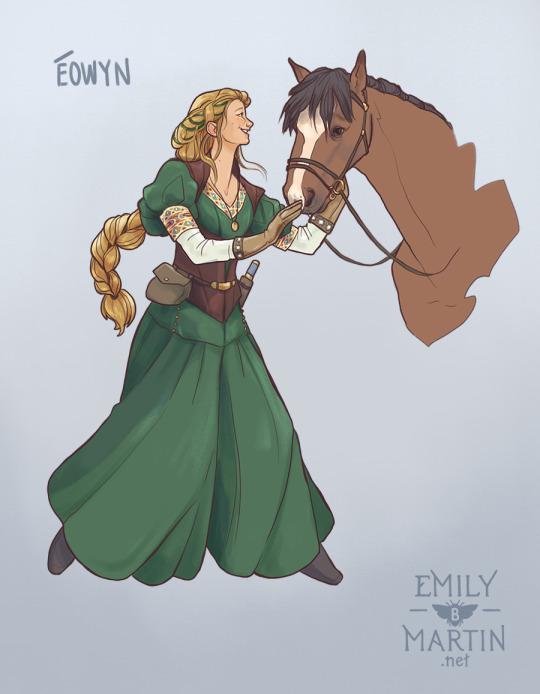
Lothiriel! I referenced her pose from my fave, @adorkastock. I don't have many headcanons about Lothiriel but I imagine she's the only person who can make Eomer trip over his own feet.
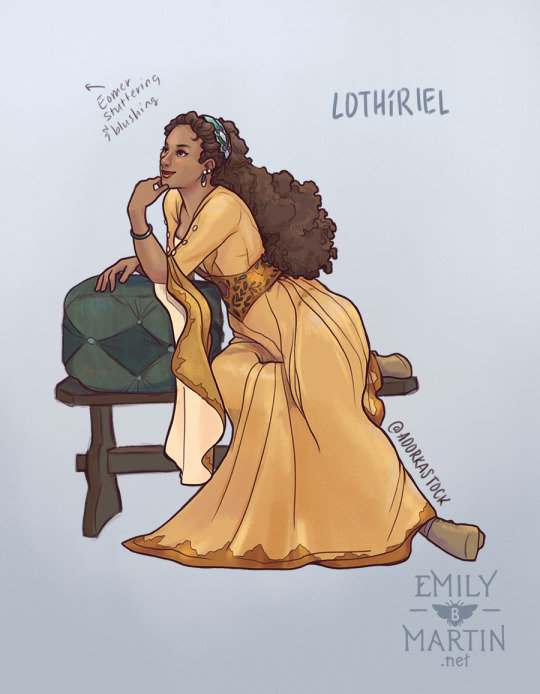
Theodwyn, Eowyn and Eomer's mother! Maybe she was born with a clubbed foot. We don't know. Tolkien only tells us she was pretty. A big thank-you to @hurricanek8art, @fruitbatvampiresociety, and @arrowpunk for giving me great feedback on her cane, including wrapping the base in leather and adding a skirt hike to her belt to keep her hem up.

Elfhild, Theoden's wife and Theodred's mother! No big headcanons here, either, but I think she'd bring Theoden a lot of joy and purpose and thus a lot of grief and aimlessness when she died.
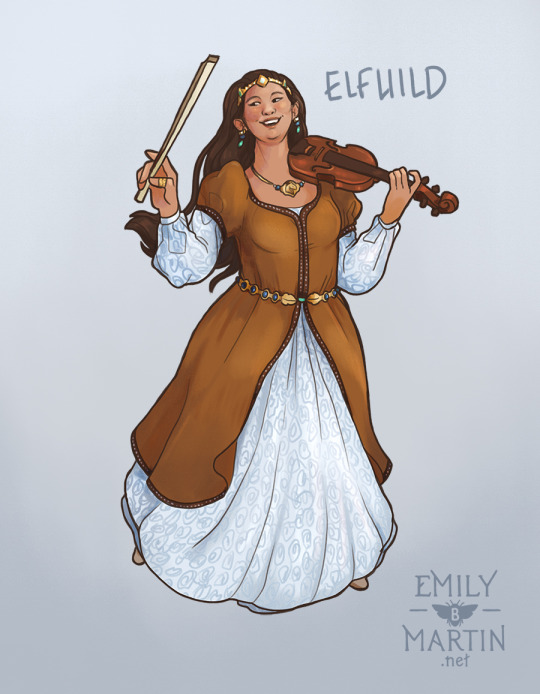
And finally, Finduilas. There's the pendant Faramir gave Eowyn, and oh, her cape clasp looks familiar.
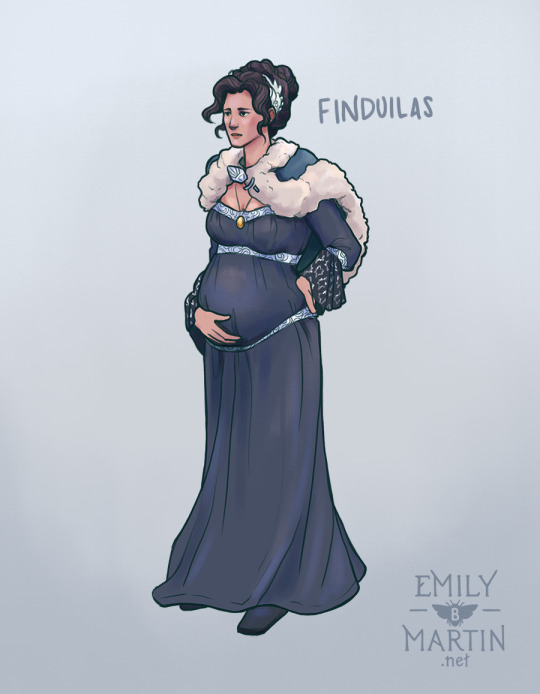
Tolkien gives us a few extra sentences about Finduilas, and so we know she had a difficult time in Minas Tirith. He writes that she was gentle and beautiful, but that "she withered in the guarded city... the shadow in the east filled her with horror, and she turned her eyes ever south to the sea that she missed." He also says Denethor "loved her, in his fashion," which I read as, "guy couldn't healthily express an emotion if it was written out for him." I imagine Finduilas was lonely and isolated, and, in pregnancy, afraid of the world she was bringing her babies into.
But maybe things weren't all bad! Maybe before she got too ill, she brought her boys to the seashore, where Faramir would babble and splash and Boromir would run all over creation and bring her treasures.
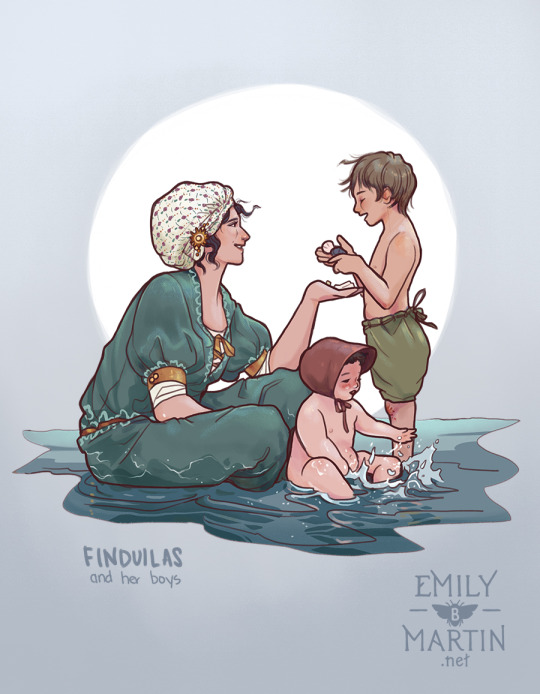
#lord of the rings#lotr#women of lord of the rings#fantasy fashion#gondor#rohan#eowyn#lothiriel#theodwyn#elfhild#finduilas#boromir#faramir
3K notes
·
View notes
Text


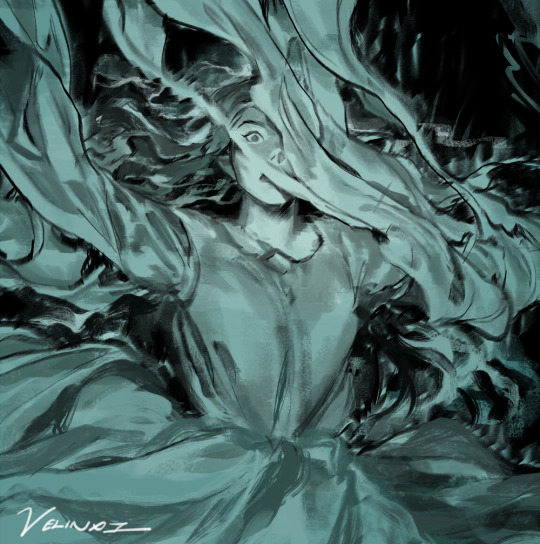
Lord of the Rings fanart! I watched for the first time recently and loved it
#vel draws#lotr#lord of the rings#yeah this was kind of random but this series brought a surprising inspo for me#have some old men and powerful women#will also have the first piece as a print for my next store update this friday!
66K notes
·
View notes
Text

all RIGHT:
Why You're Writing Medieval (and Medieval-Coded) Women Wrong: A RANT
(Or, For the Love of God, People, Stop Pretending Victorian Style Gender Roles Applied to All of History)
This is a problem I see alllll over the place - I'll be reading a medieval-coded book and the women will be told they aren't allowed to fight or learn or work, that they are only supposed to get married, keep house and have babies, &c &c.
If I point this out ppl will be like "yes but there was misogyny back then! women were treated terribly!" and OK. Stop right there.
By & large, what we as a culture think of as misogyny & patriarchy is the expression prevalent in Victorian times - not medieval. (And NO, this is not me blaming Victorians for their theme park version of "medieval history". This is me blaming 21st century people for being ignorant & refusing to do their homework).
Yes, there was misogyny in medieval times, but 1) in many ways it was actually markedly less severe than Victorian misogyny, tyvm - and 2) it was of a quite different type. (Disclaimer: I am speaking specifically of Frankish, Western European medieval women rather than those in other parts of the world. This applies to a lesser extent in Byzantium and I am still learning about women in the medieval Islamic world.)
So, here are the 2 vital things to remember about women when writing medieval or medieval-coded societies
FIRST. Where in Victorian times the primary axes of prejudice were gender and race - so that a male labourer had more rights than a female of the higher classes, and a middle class white man would be treated with more respect than an African or Indian dignitary - In medieval times, the primary axis of prejudice was, overwhelmingly, class. Thus, Frankish crusader knights arguably felt more solidarity with their Muslim opponents of knightly status, than they did their own peasants. Faith and age were also medieval axes of prejudice - children and young people were exploited ruthlessly, sent into war or marriage at 15 (boys) or 12 (girls). Gender was less important.
What this meant was that a medieval woman could expect - indeed demand - to be treated more or less the same way the men of her class were. Where no ancient legal obstacle existed, such as Salic law, a king's daughter could and did expect to rule, even after marriage.
Women of the knightly class could & did arm & fight - something that required a MASSIVE outlay of money, which was obviously at their discretion & disposal. See: Sichelgaita, Isabel de Conches, the unnamed women fighting in armour as knights during the Third Crusade, as recorded by Muslim chroniclers.
Tolkien's Eowyn is a great example of this medieval attitude to class trumping race: complaining that she's being told not to fight, she stresses her class: "I am of the house of Eorl & not a serving woman". She claims her rights, not as a woman, but as a member of the warrior class and the ruling family. Similarly in Renaissance Venice a doge protested the practice which saw 80% of noble women locked into convents for life: if these had been men they would have been "born to command & govern the world". Their class ought to have exempted them from discrimination on the basis of sex.
So, tip #1 for writing medieval women: remember that their class always outweighed their gender. They might be subordinate to the men within their own class, but not to those below.
SECOND. Whereas Victorians saw women's highest calling as marriage & children - the "angel in the house" ennobling & improving their men on a spiritual but rarely practical level - Medievals by contrast prized virginity/celibacy above marriage, seeing it as a way for women to transcend their sex. Often as nuns, saints, mystics; sometimes as warriors, queens, & ladies; always as businesswomen & merchants, women could & did forge their own paths in life
When Elizabeth I claimed to have "the heart & stomach of a king" & adopted the persona of the virgin queen, this was the norm she appealed to. Women could do things; they just had to prove they were Not Like Other Girls. By Elizabeth's time things were already changing: it was the Reformation that switched the ideal to marriage, & the Enlightenment that divorced femininity from reason, aggression & public life.
For more on this topic, read Katherine Hager's article "Endowed With Manly Courage: Medieval Perceptions of Women in Combat" on women who transcended gender to occupy a liminal space as warrior/virgin/saint.
So, tip #2: remember that for medieval women, wife and mother wasn't the ideal, virgin saint was the ideal. By proving yourself "not like other girls" you could gain significant autonomy & freedom.
Finally a bonus tip: if writing about medieval women, be sure to read writing on women's issues from the time so as to understand the terms in which these women spoke about & defended their ambitions. Start with Christine de Pisan.
I learned all this doing the reading for WATCHERS OF OUTREMER, my series of historical fantasy novels set in the medieval crusader states, which were dominated by strong medieval women! Book 5, THE HOUSE OF MOURNING (forthcoming 2023) will focus, to a greater extent than any other novel I've ever yet read or written, on the experience of women during the crusades - as warriors, captives, and political leaders. I can't wait to share it with you all!
#watchers of outremer#medieval history#the lady of kingdoms#the house of mourning#writing#writing fantasy#female characters#medieval women#eowyn#the lord of the rings#lotr#history#historical fiction#fantasy#writing tip#writing advice
29K notes
·
View notes
Text
it's fascinating that those biphobes compare women liking astarion to women liking legolas and they mention a popular post that says "I never understood why so many straight women are into legolas. what do you think he is going to do? top you?" they bring this post up like some sort of proof "haha. so right. so true."
EXCEPT the notes on that popular post are filled with THOUSANDS of women commenting "no. I am gonna top him" and "bold of you to assume women can't top" and a lot of them are bisexual women commenting "I am bi and I only like men who look like a girl lol" honestly relatable Lmao
they act like that shitpost is pointing out some truth about how those women are silly. but the replies on that post show the stupidity of that assumption. people really don't get that feminine looking women don't just want to be rough handled by some masculine dude. and people have varied tastes and sexual desires. there is so much misogyny all tangled up in the biphobia. but it's subtle in a way that they don't notice their views on these matters are flawed because even when we point out what's wrong with these gender essentialist stereotypes, they ignore it and treat it as a joke "haha you all act like we wanted to behead bisexuals"
#my thoughts#I say this as someone who doesn't give a fuck about legolas#but acting like that post is so true is dumb#like those women don't know what they chose to like...#or like a man with pretty long hair and clean shaven face cannot possibly like women... laughing my ass off#my post#my posts#biphobia#text post#textposts#bg3 mine#misogyny#tumblr bullshit#2k#1k#lgbtq#baldur's gate 3#astarion#legolas#the lord of the rings
2K notes
·
View notes
Text
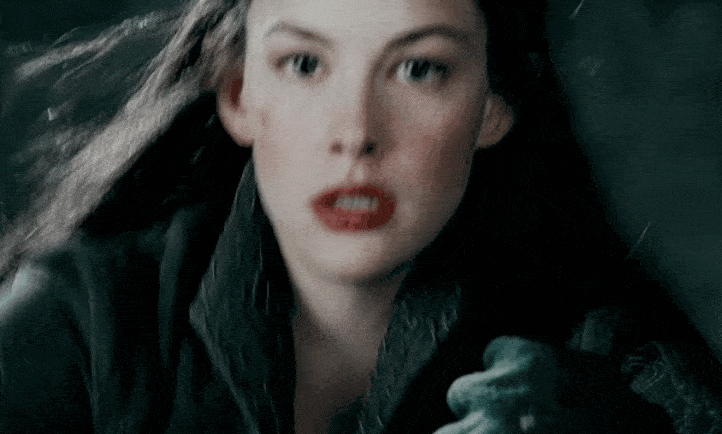
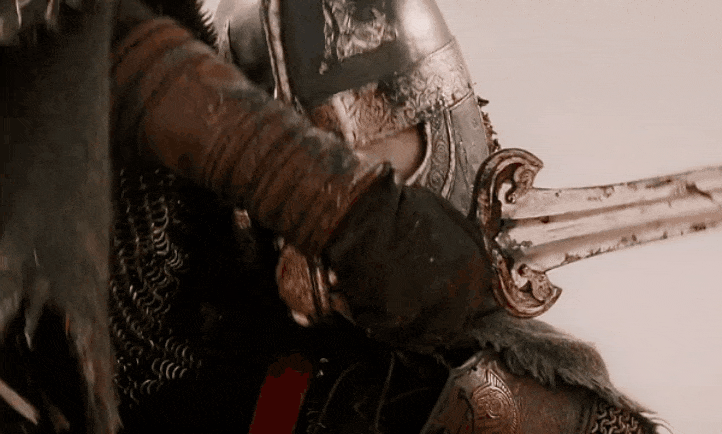
Happy International Women's Day 💗🌷
#lotr#lord of the rings#the lord of the rings#girl power motherfucker#eowyn#éowyn#arwen#lotr arwen#arwen undómiel#arwen evenstar#rotk#fotr#tolkien#lotr gifs#lotr edit#lotredit#middle earth#Middle-Earth#jrrt#international women's day
689 notes
·
View notes
Text
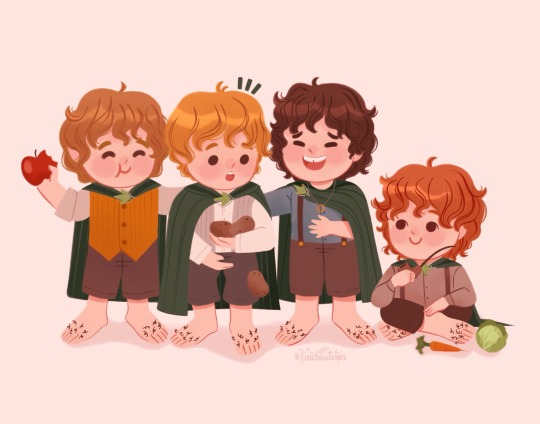
Hobbitses
#illustration#artists on tumblr#my art#digital art#women artists#drawing#procreate art#fanart#lotr#lord of the rings#hobbits#merry brandybuck#peregrine took#samwise gamgee#frodo baggins#po tay toes
549 notes
·
View notes
Photo

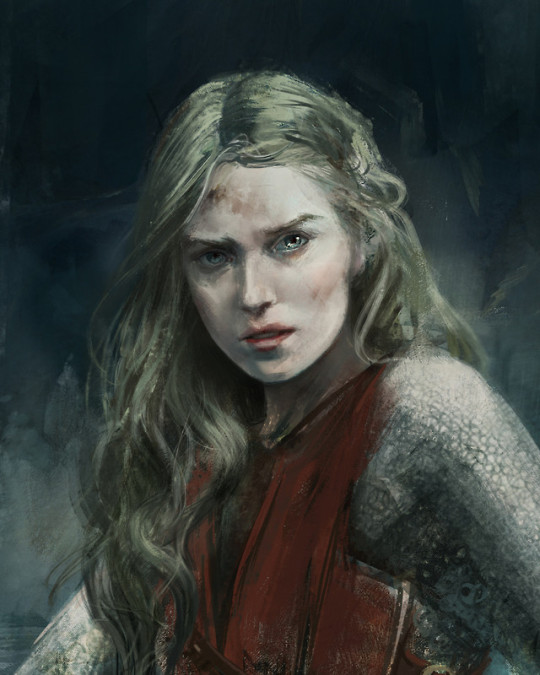
Éowyn
‘A sword rang as it was drawn. “Do what you will; but I will hinder it, if I may.”’
I painted this back in November 2017, on the kind request of Will o' Wisps for John Howe’s visit to AthensCon 2017. I had the good fortune to meet him there and give him a print of it. He had very kind words about it, leaving me on cloud nine, because Howe is one of my earliest art heroes.
The Lord of the Rings has very few women characters in it, something that has been the point of criticism almost from its publication in the 50s. It might be for this reason that Éowyn stood out for me, but also because I was moved by how much understanding Tolkien showed for her situation. When she wants to go to war, she is dissuaded by Aragorn, and is rightly bitter about it:
‘She answered: "All your words are but to say: you are a woman, and your part is in the house. But when the men have died in battle and honour, you have leave to be burned in the house, for the men will need it no more. But I am of the House of Eorl and not a serving-woman. I can ride and wield blade, and I do not fear either pain or death."
"What do you fear, lady?" he asked.
"A cage," she said. "To stay behind bars, until use and old age accept them, and all chance of doing great deeds is gone beyond recall or desire.”’
Tolkien gave Éowyn a voice, and not only that, but also a chance to prove her valour and to change the course of the history of Middle Earth as no one else but her could have. He wrote little of women, it’s true. The little he did write, though, was with deep humanity.
#Éowyn#eowyn#eilidh#eleni tsami#lotr#the lord of the rings#women in armor#women warriors#fantasy#Illustration#digital painting#tolkien
419 notes
·
View notes
Text
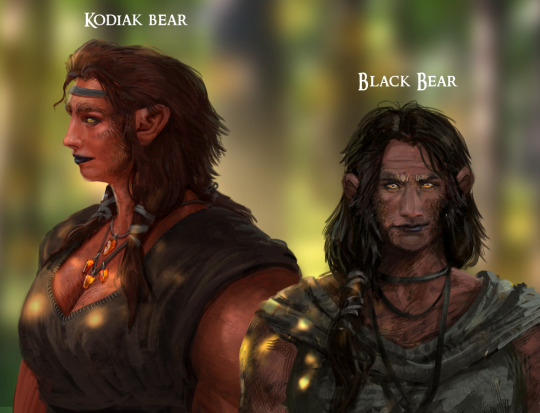
Bear women from Middle Earth
#beorning#beornings#beorning women#my art#the hobbit#tolkien#lotr#the lord of the rings#lord of the rings#the silmarillion#middle earth#jrr tolkien#tolkien fanart#skin-changers#western beornings#GIANT BEAR LADIES#yeee
503 notes
·
View notes
Text
I just realized that I’m not following enough blogs, so...
Reblog if you like/love any of the following:
Little Women
Anne of Green Gables
The Lord of the Rings
The Chronicles of Narnia
Doctor Who
Steven Universe
Gravity Falls
Amphibia
The Owl House
Percy Jackson
The Beatles
The Beach Boys
The Monkees
Pink Floyd
Queen
Anything 60′s or 70′s related
#little women#anne of green gables#the lord of the rings#the chronicles of narnia#doctor who#steven universe#gravity falls#amphibia#the owl house#percy jackson#the beatles#the beach boys#the monkees#pink floyd#Queen#60's#70's#here we go
800 notes
·
View notes
Text
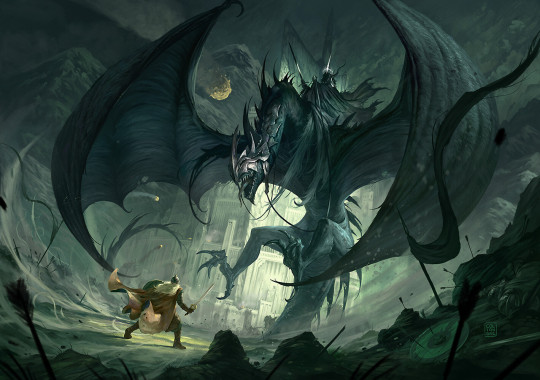


LOTR: Eowyn & Witch King Angmar by Coliandre
#lord of the rings#the witch king of angmar#eowyn#pelennor fields#warrior women#fantasy art#middle earth
194 notes
·
View notes
Text
I truly and deeply love Eowyn because she's angry, bitter and can be genuinely cold when we meet her - and she's only 24! already she's changed by this war, by the loss of her parents, by the long period of her life where she had no parental figure because Theoden was battling his own depression, and by Grima being a creep. Tolkien's young characters go to war and are changed by it, like Pippin, like Sam, who is still quite a young hobbit (he's 39, and they come of age at 33), but not her - she is already deep in grim thoughts about dying for honour, cheerless, cold.
I don't like comparing all Tolkien women to one another because they are quite different from each other and comparing them just because they're women often feels reductive because they serve vastly different roles in the story, but when you're considering how he presents femininity, it's necessary to do so. so far we've met Lobelia, Mrs. Maggot, Goldberry, Arwen, Galadriel and Eowyn (Rosie was only mentioned as far as i remember?). hobbit women we meet while we are still at home, and they fit right into the homey atmosphere of the shire, in which characters are often presented playfully, or have one defining trait (think about the characters we only know from notes attached to bilbo's "gifts"). further from home, we meet goldberry, arwen and galadriel, who are old, fair, good, beautiful. each of them is different (and galadriel especially has a dark, flawed part of her we can see), but with the women meet on the journey, further from home, a pattern starts to emerge - they come from a different time, from a different world, and even with all their fairness and kindness they can at times feel distant, out of reach.
and then!! eowyn comes into the picture, and- she could be you. she could be me. she's not only complex, but also within reach. she's not a gentle or joyful presence, she's not a powerful ancient force, she doesn't come bearing gifts for everyone - she's so full of negative emotions and pain which she needs to heal from, she's so young and already feels like an old, weary soul.
and it's not to say one kind of character is better than the other, or more complex or anything, because that's exactly the reductive way of looking at those women that I don't like seeing in discussions. ultimately, they are all just different people. but the introduction of eowyn broadens the spectrum of femininity shown in LOTR, and while it's still not exactly wide, it's a bit wider than it was before.
#then of course we meet ioreth who is again different but that happens later and i wanted to cover the progression so far#lotr newsletter#it's honestly accidental that this post came to my mind on women's day of all days askjhkdhdkj#anyways happy women's day! trans women are women#it's mine my own my precious#eowyn#arwen#galadriel#lobelia#rosie#goldberry#mrs. maggot#lotr#the lord of the rings
1K notes
·
View notes
Text
So here's one of the coolest things that has happened to me as a Tolkien nut and an amateur medievalist. It's also impacted my view of the way Tolkien writes women.
Here's Carl Stephenson in MEDIEVAL FEUDALISM, explaining the roots of the ceremony of knighthood:
"In the second century after Christ the Roman historian Tacitus wrote an essay which he called Germania, and which has remained justly famous. He declares that the Germans, though divided into numerous tribes, constitute a single people characterised by common traits and a common mode of life. The typical German is a warrior. [...] Except when armed, they perform no business, either private or public. But it is not their custom that any one should assume arms without the formal approval of the tribe. Before the assembly the youth receives a shield and spear from his father, some other relative, or one of the chief men, and this gift corresponds to the toga virilis among the Romans--making him a citizen rather than a member of a household" (pp 2-3).
Got it?
Remember how Tolkien was a medievalist who based his Rohirrim on Anglo-Saxon England, which came from those Germanic tribes Tacitus was talking about?
Stephenson argues that the customs described by Tacitus continued into the early middle ages eventually giving rise to the medieval feudal system. One of these customs was the gift of arms, which transformed into the ceremony of knighthood:
"Tacitus, it will be remembered, describes the ancient German custom by which a youth was presented with a shield and a spear to mark his attainment of man's estate. What seems to the be same ceremony reappears under the Carolingians. In 791, we are told, Charlemagne caused Prince Louis to be girded with a sword in celebration of his adolescence; and forty-seven years later Louis in turn decorated his fifteen-year-old son Charles "with the arms of manhood, i.e., a sword." Here, obviously, we may see the origin of the later adoubement, which long remained a formal investiture with arms, or with some one of them as a symbol. Thus the Bayeux Tapestry represents the knighting of Earl Harold by William of Normandy under the legend: Hic Willelmus dedit Haroldo arma (Here William gave arms to Harold). [...] Scores of other examples are to be found in the French chronicles and chansons de geste, which, despite much variation of detail, agree on the essentials. And whatever the derivation of the words, the English expression "dubbing to knighthood" must have been closely related to the French adoubement" (pp 47-48.)
In its simplest form, according to Stephenson, the ceremony of knighthood included "at most the presentation of a sword, a few words of admonition, and the accolade."
OK. So what does this have to do with Tolkien and his women? AHAHAHAHA I AM SO GLAD YOU ASKED. First of all, let's agree that Tolkien, a medievalist, undoubtedly was aware of all the above. Second, turn with me in your copy of The Lord of the Rings to chapter 6 of The Two Towers, "The King of the Golden Hall", when Theoden and his councillors agree that Eowyn should lead the people while the men are away at war. (This, of course, was something that medieval noblewomen regularly did: one small example is an 1178 letter from a Hospitaller knight serving in the Latin kingdom of Jerusalem which records that before marching out to the battle of Montgisard, "We put the defence of the Tower of David and the whole city in the hands of our women".) But in The Lord of the Rings, there's a little ceremony.
"'Let her be as lord to the Eorlingas, while we are gone.'
'It shall be so,' said Theoden. 'Let the heralds announce to the folk that the Lady Eowyn will lead them!'
Then the king sat upon a seat before his doors and Eowyn knelt before him and received from him a sword and a fair corselet."
I YELLED when I realised what I was reading right there. You see, the king doesn't just have the heralds announce that Eowyn is in charge. He gives her weapons.
Theoden makes Eowyn a knight of the Riddermark.
Not only that, but I think this is a huge deal for several reasons. That is, Tolkien knew what he was doing here.
From my reading in medieval history, I'm aware of women choosing to fight and bear arms, as well as becoming military leaders while the men are away at some war or as prisoners. What I haven't seen is women actually receiving knighthood. Anyone could fight as a knight if they could afford the (very pricy) horse and armour, and anyone could lead a nation as long as they were accepted by the leaders. But you just don't see women getting knighted like this.
Tolkien therefore chose to write a medieval-coded society, Rohan, where women arguably had greater equality with men than they did in actual medieval societies.
I think that should tell us something about who Tolkien was as a person and how he viewed women - perhaps he didn't write them with equal parity to men (there are undeniably more prominent male characters in The Lord of the Rings and The Hobbit, at least, than female) but compared to the medieval societies that were his life's work, and arguably even compared to the society he lived in, he was remarkably egalitarian.
I think it should also tell us something about the craft of writing fantasy.
No, you don't have to include gut wrenching misogyny and violence against women in order to write "realistic" medieval-inspired fantasy.
Tolkien's fantasy worlds are DEEPLY informed by medieval history to an extent most laypeople will never fully appreciate. The attitudes, the language, the ABSOLUTELY FLAWLESS use of medieval military tactics...heck, even just the way that people travel long distances on foot...all of it is brilliantly medieval.
The fact that Theoden bestows arms on Eowyn is just one tiny detail that is deeply rooted in medieval history. Even though he's giving those arms to a woman in a fantasy land full of elves and hobbits and wizards, it's still a wonderfully historically accurate detail.
Of course, I've ranted before about how misogyny and sexism wasn't actually as bad in medieval times as a lot of people today think. But from the way SOME fantasy authors talk, you'd think that historical accuracy will disappear in a puff of smoke if every woman in the dragon-infested fantasy land isn't being traumatised on the regular.
Tolkien did better. Be like Tolkien.
#tolkien#middle earth#jrr tolkien#lord of the rings#lotr#the lord of the rings#eowyn#writing fantasy#fantasy#female characters#writing#historical fiction#medieval women#medieval history#medieval#history#womens history
8K notes
·
View notes
Text
I love how the MTG community went crazy yesterday because a card from the new set based on Lord of the Rings depictting Goldberry was revealed and, well

everyone got horny for this thicc queen
464 notes
·
View notes
Text
"Work, skills and traits that have traditionally been seen as characteristics of and appropriate for women shouldn't be derided or minimised in favour of skills and traits associated with men, and should be respected"
is a valid point, but so is;
"women shouldn't be forced to stick to work, skills and traits that are traditionally seen as womanly, even if they are valuable and important to society, and they have every right to resent and dislike a societal role and code of behaviour that has been inflicted on them regardless of ability, interest or inclination, because of something as arbitrary as gender".
Period heroines complaining about needlework and housekeeping, and fantasy heroines dreaming of sword fighting and adventures, are not a problem, and actually do give voice to the many women in the world who didn't and still don't fit into what society has decided women should be.
#feminism#fandom wank#fandom sexism#ASOIAF#A Song of Ice and Fire#Game of Thrones#Arya Stark#Brienne of Tarth#Little Women#Jo March#Bridgerton#Eloise Bridgerton#LOTR#Lord of the Rings#Eowyn#HOTD#House of the Dragon#Rhaenyra Targaryen
271 notes
·
View notes
Text

Galadriel ✨
#galadriel#illustration#artists on tumblr#my art#digital art#women artists#fanart#the rings of power#lord of the rings#jrr tolkien#lady of light#fantasy art#lotr
2K notes
·
View notes
Text
men who hate people having their silly little lotr ships are so silly and get so wound up about how someone else has interpreted a piece of fiction
like girl i literally don’t care if you don’t ship them why are you all up in MY business about how i’ve interpreted legolas and gimli’s ending as aligning with early-mid 20th century queer coding??
#lotr#lord of the rings#the hobbit#tolkien#gimleaf#gigolas#makes me angry and also amuses me#sure the dude who runs around singing silly songs isn’t at least a LITTLE BIT gay??#wdym most of the other male characters get married to women and have children?#and these two go off together and then sail to elf heaven??#like that’s basically how queer couples existed for a large portion of history
267 notes
·
View notes